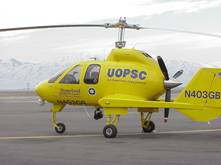
The Bensen B-8 is a small, single-seat autogyro developed in the United States in the 1950s. Although the original manufacturer stopped production in 1987, plans for homebuilders are still available as of 2019. Its design was a refinement of the Bensen B-7, and like that aircraft, the B-8 was initially built as an unpowered rotor-kite. It first flew in this form in 1955, and on 6 December a powered version, designated B-8M first flew. The design proved to be extremely popular and long-lasting, with thousands of sets of plans sold over the next thirty years.

The Cierva C.30 is an autogyro designed by Juan de la Cierva and built under licence from the Cierva Autogiro Company by A V Roe & Co Ltd (Avro), Lioré-et-Olivier and Focke-Wulf.

The Cierva C.19 was a 1930s British two-seat autogyro, designed by Spanish engineer Juan de la Cierva. It was built by Avro as the Avro Type 620. It proved to be the most successful and widely produced of the early de la Cierva designs.

The Pitcairn PA-34 and Pitcairn PA-33, given the United States Navy (USN) designation Pitcairn OP-2 and United States Army designation Pitcairn YG-2 respectively were reconnaissance autogyros designed and built in 1936 for evaluation.
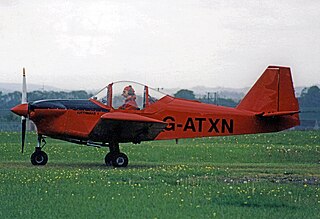
The Mitchell Kittiwake is a British single engine sporting aircraft designed for amateur building. Plans were available for both single-seat and two-seat versions, but only four were constructed.
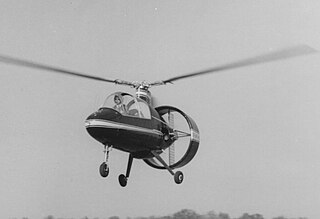
The Avian 2/180 Gyroplane was a two-seat, single-engine autogyro built in Canada in the 1960s. Several prototypes were built but production was not achieved.

The RemSchetMash RSM-15 Robust is a single-seat, single-engine ultralight built in Ukraine. It first flew in 2006 but no production aircraft had been produced by late 2009.

The I.S.T. XL-14 Maya was a single-engine, light experimental aircraft designed and built in the Philippines in the early 1950s to investigate the use of indigenous materials in aircraft construction. Its construction uses a type of woven bamboo.

The AAI SparrowHawk is an American two-seat pusher ultralight autogyro, available in kit form for amateur construction.
The CSIR SARA II is a South African two-seat experimental autogyro designed and built by the Aeronautics Research Unit of the Council for Scientific and Industrial Research.

The Irkut A-002 is a three-seat, pusher configuration autogyro developed in Russia through the 2000s by the United Constructor Bureau for Light Aircraft team of the Irkutsk Aircraft Production Association (IAPO) "Irkut" as the first independent product. Take-off is possible when wind speed exceeds 8 m/s, otherwise a running start of up to 15 m is necessary. The riveted covering is made of duralumin. The first produced consignment consisted of five autogyros. The A-002M is a further development.
The OSKBES MAI-208 is a single-engine, two-seat autogyro, designed and built in Russia, which utilises the fuselage of the MAI-223 ultralight. It had been completed but not flown by spring 2010.
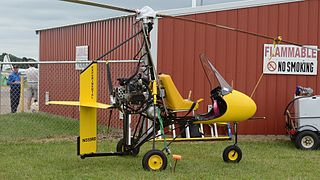
The Rotor Flight Dynamics Dominator is an American autogyro designed by Ernie Boyette of Rotor Flight Dynamics of Wimauma, Florida, and made available in the form of plans and kits for amateur construction.

The Kawasaki KAT-1 is a Japanese primary trainer, seating two in tandem, designed to compete for a Japanese Air Defense Force (JADF) contract in the mid-1950s. Only two were completed.

The Rabouyt D2 was a two-seat autogyro, with an engine driven rotor for vertical take-offs. In level flight the aircraft was powered by the same engine driving a shrouded, pusher configuration propeller. It was designed and built in France in the early 1970s by Denis Rabouyt.
The Phenix Aviation Phenix is a Spanish autogyro, under development by Phenix Aviation of Alicante. The aircraft is intended to be supplied as a complete ready-to-fly-aircraft.
The Westland CL.20 was a two-seat autogyro designed and built by Westland Aircraft between 1934 and 1938. One flying prototype and six airframes were built, which had control problems and insufficient lift. Before these problems could be solved the programme was abandoned and the prototype was scrapped in 1938.
The SNCASE SE-700 was a three-seat passenger autogyro designed during World War II. Two were completed but only the first flew and the programme was soon abandoned.
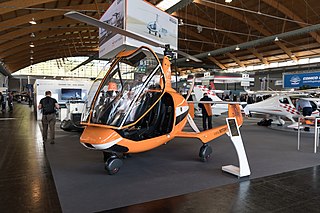
The Rotorvox C2A is a two-seat, pusher configuration autogyro developed in Germany.

The 1933 experimental Pitcairn PA-22 was one of the first wingless autogyros. It was controlled by movement of the rotor plane rather than the usual control surfaces, though initially the much modified lone example retained rudders as a precaution.
